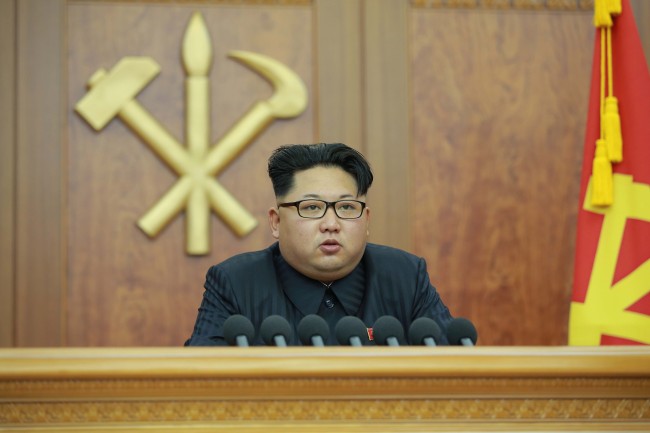North Korea’s dogged pursuit of nuclear armament is drawing attention to what kind of nuclear strategy it has been pursuing and whether it would ever use its atomic bomb in any conflict with its potential adversaries including the U.S. and South Korea.
 |
| North Korea leader Kim Jong-un delivers his New Year`s address. (Yonhap) |
Pyongyang has so far been striving to nuclearize itself apparently to raise its bargaining power, fend off threats of a regime change, deter nuclear attacks or any blackmail from hostile forces, bolster national pride and achieve reunification on its own terms.
With these purposes in mind, the communist regime has sought to become a nuclear power over the last two decades. But its nuclear strategy appears to be still in the making or in its infancy given that it has yet to develop and deploy fully operational nuclear weapons.
“The development of Pyongyang’s nuclear strategy would be just in its initial stage. But with the evolving nuclear technology and enlarged inventory, it would continue to refine its strategy while thinking of how to use it in international politics,” said Yang Wuk, a senior research fellow at the Korea Defense and Security Forum.
“But the crux of the North’s rudimentary strategy would be deterrence, and it may also contemplate how to use it to coerce its neighboring countries to offer what it wants or stop what it does not want them to do.”
Given its stated “no-first-use” policy, the centerpiece of its nuclear strategy appears to be maintaining deterrence through the possibility of “assured destruction.” During the Cold War, the U.S. and the then Soviet Union maintained “nuclear peace” through the principle of “mutual assured destruction” in which both the victim and the attacker would perish or suffer serious damages.
As the North has sought to develop a submarine-launched ballistic missile in recent years, some analysts noted that the reclusive regime may be leaning toward a strategy of “minimum deterrence” rather than pursuing an inventory of massive nuclear arms.
The development of the SLBM is expected to enable the North to pursue only minimum deterrence as the underwater weapons system would offer it a means to survive the so-called “first strike” from its enemy forces. Even if it suffers a first nuclear strike, Pyongyang could launch a retaliatory “second strike” with the SLBM.
“North Korea may believe that it can maintain deterrence against the U.S. if it secures a credible ‘second-strike capability.’ If you are able to launch a retaliatory nuclear counterstrike, it doesn’t really matter how many nuclear warheads you have — a reason why China initially maintained the doctrine of minimum deterrence,” said Sheen Seong-ho, a professor at Seoul National University’s Graduate School of International Studies.
“But realistically speaking, developing the SLBM is not easy. It also means developing a nuclear-powered submarine that can travel far enough and should be large enough to mount the ballistic missile.”
Major countries have sought to secure nuclear arms largely for four main objectives: defense, deterrence, compellence (the ability of one state to coerce another state into action, usually by threatening punitive actions) and swaggering.
Noting Pyongyang’s persistent efforts to use the nuclear weapons to flaunt its military clout for both domestic and international audiences, experts say that the objective of “swaggering“ would also be of crucial importance for the North.
To further bolster deterrence, the North could start thinking about a strategy of “limited use,” Joel Wit, a senior fellow with the U.S.-Korea Institute at the Johns Hopkins University’s School of Advanced International Studies, said in a Seoul forum last November.
“What we are seeing also is (North Korea’s) thinking about limited options — not so much that they are planning on using them, but just as a way of bolstering deterrence,” he said.
“It wouldn’t be surprising because countries who face conventional superior opponents often go to the possibility of limited nuclear use early in a conflict in order to deter those conventionally superior opponents. So the prime example nowadays is Pakistan facing India. That is very clear.”
As many experts warned, the North’s use of nuclear arms would be the end of the regime as the international community would not let it go unpunished. Yet, the problem always lies with the fact that the regime has always been “unpredictable” and sometimes “irrational,” experts said.
They also pointed out that the concept of deterrence based on “rational thinking” does not seem to apply to North Korea-related cases.
“Vis-a-vis North Korea, it is hard to apply the kind of a nuclear deterrence strategy the major powers have hitherto used, as the strategy has been based on the belief that the other side would think rationally and predictably,” said Park Won-gon, security expert at Handong Global University.
“Thus, the variable of the North Korean leadership always spawns the risks of nuclear attacks. As Kim calls all the shots in the dictatorial regime, there is nothing to keep him in check.”
By Song Sang-ho (sshluck@heraldcorp.com)

